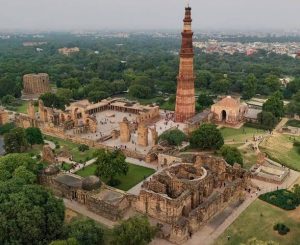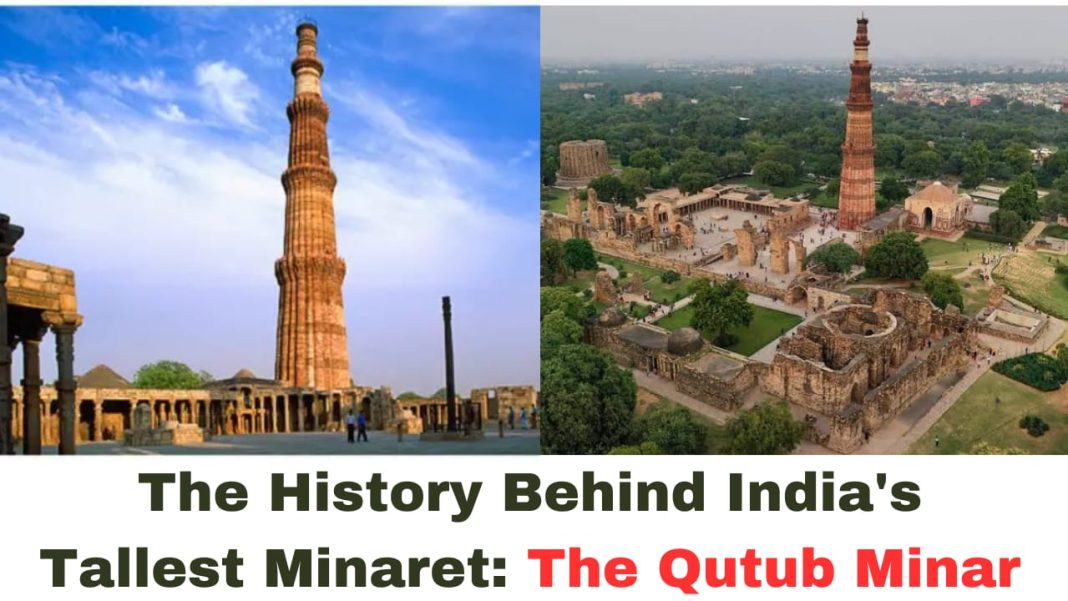Digital News Guru History Desk:
Qutub Minar
The Qutub Minar, one of India’s most iconic monuments, stands tall as a symbol of India’s rich historical and architectural heritage. Located in the Qutub complex in Mehrauli, New Delhi, this majestic minaret has a history that spans centuries. It is an outstanding example of Indo-Islamic Afghan architecture, an important landmark in the history of the Delhi Sultanate, and a testament to the grandeur of medieval India.
Early Origins and Construction
The story of the Qutub Minar begins in the early 13th century, following the establishment of the Delhi Sultanate. In 1192, after the defeat of the Rajput King Prithviraj Chauhan by Muhammad Ghori at the Second Battle of Tarain, Delhi came under Muslim rule. Ghori’s lieutenant, Qutb-ud-Din Aibak, became the first ruler of the Delhi Sultanate, initiating a new era of Muslim dominance in northern India.

Qutb-ud-Din Aibak, the founder of the Mamluk dynasty (also known as the Slave dynasty), commissioned the construction of the Qutub Minar around 1193. The minaret was intended to be a tower of victory, marking the establishment of Muslim rule in India. The minar was also meant to serve as a symbol of the Islamic faith, with an inscription at the top of the tower that calls it a “minaret of victory,” celebrating the Muslim conquest of Delhi.
Architectural Details
The Qutub Minar stands at an impressive height of 72.5 meters (238 feet), making it the tallest brick minaret in the world. It is constructed primarily of red sandstone, with intricate carvings and verses from the Quran. The tower is cylindrical in shape and tapers as it rises, with a total of five distinct stories. Each story is adorned with a projecting balcony, offering a stunning view of the surrounding area.
The base of the Qutub Minar is adorned with detailed inscriptions in Arabic, which document the history of the monument and its construction. The first three stories of the tower were built by Qutb-ud-Din Aibak, while the remaining two stories were completed by his successor, Iltutmish. The first floor of the tower features intricate carvings, including motifs of foliage, and it is also where the first set of inscriptions are found, commemorating the conquest of Delhi and the building of the Qutub Minar.

The tower is topped with a dome, which was originally a wooden structure but was later replaced with an iron structure. The top of the tower features a small balcony, which provided an elevated view of the surrounding area. The minaret’s primary function was to serve as a watchtower for the surrounding region, allowing the ruler and his officials to survey the area for any potential threats.
The Role of Iltutmish
While Qutb-ud-Din Aibak initiated the construction of the Qutub Minar, it was his successor, Shams-ud-Din Iltutmish, who completed it. Iltutmish, who ruled from 1211 to 1236, was one of the most significant sultans of the Delhi Sultanate and played a major role in consolidating Muslim rule in India. He also built the final two stories of the Qutub Minar and added further inscriptions to the monument.
Under Iltutmish’s reign, the Delhi Sultanate experienced significant growth and prosperity. The expansion of the empire was reflected in the grandeur of the Qutub Minar, which not only symbolized the Sultanate’s military victories but also served as a statement of the power and cultural influence of the Islamic Empire in India.
The Contribution of Ala-ud-Din Khilji
The Qutub Minar underwent further modifications during the reign of Ala-ud-Din Khilji, one of the most famous rulers of the Delhi Sultanate. Khilji is known for his military campaigns, administrative reforms, and architectural contributions. He made significant additions to the Qutub Minar, including the construction of a large mosque in the complex, known as the Quwwat-ul-Islam Mosque, which remains one of the oldest surviving mosques in India.

During this period, the Qutub Minar and the surrounding area became a hub of Islamic architectural activity. The Quwwat-ul-Islam Mosque, which was built using columns from Hindu temples, demonstrates the fusion of Islamic and Indian architectural styles during the medieval period. This unique blending of cultures is a characteristic feature of much of the architecture of the Delhi Sultanate.
The Restoration of the Qutub Minar
Throughout the centuries, the Qutub Minar has experienced numerous periods of neglect, damage, and restoration. The most significant damage occurred in the 14th century when a major earthquake caused a portion of the tower to collapse. It was later restored by the Sultan of Delhi, Firoz Shah Tughlaq, who rebuilt the top floor of the minaret and added an additional layer to the structure.
In the following centuries, further damage to the minaret was caused by natural disasters and the passage of time. However, the British colonial administration, which took control of India in the 19th century, undertook substantial restoration work on the Qutub Minar. The British architect Sir Alexander Cunningham, along with his team, oversaw the restoration of the minaret in the mid-1800s, ensuring its preservation as a national monument.
Symbol of India’s Architectural Heritage
Today, the Qutub Minar is not only a symbol of the triumph of Islam in India but also an enduring example of the country’s cultural and architectural history. The monument is part of the UNESCO World Heritage Site, the Qutub Complex, which includes other historic structures like the Quwwat-ul-Islam Mosque, the Iron Pillar of Delhi, and the tomb of Iltutmish.

The Qutub Minar continues to draw visitors from around the world, who come to admire its architectural beauty, historical significance, and the role it plays in understanding the complex cultural heritage of India. The minaret, despite undergoing several changes over the centuries, remains an enduring symbol of the legacy of the Delhi Sultanate and the powerful dynasty that once ruled over the subcontinent.
Conclusion
The Qutub Minar is not just a historical landmark; it is a monument that represents a fusion of cultures, a symbol of victory, and a testament to the architectural achievements of medieval India. From its origins in the 12th century to its restoration in modern times, the Qutub Minar has stood as a silent witness to the changing tides of history. Today, it remains one of the most admired and celebrated monuments of India, drawing visitors from across the globe who come to marvel at its grandeur and significance.
You May Also Read: RBI Customer Care Receives Bomb Threat from Alleged “Lashkar CEO”








